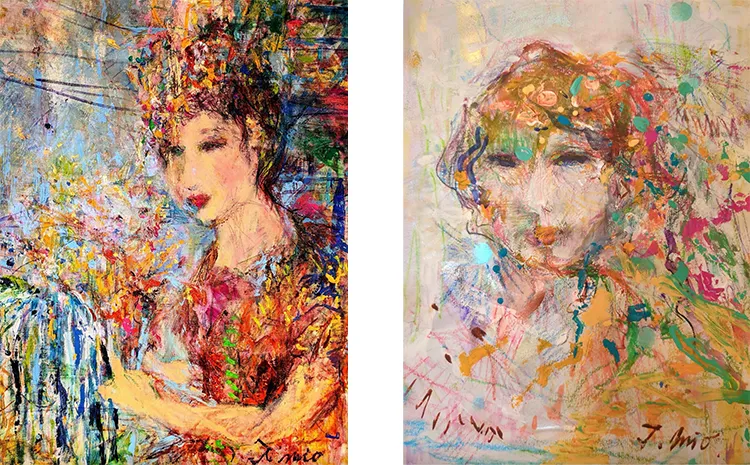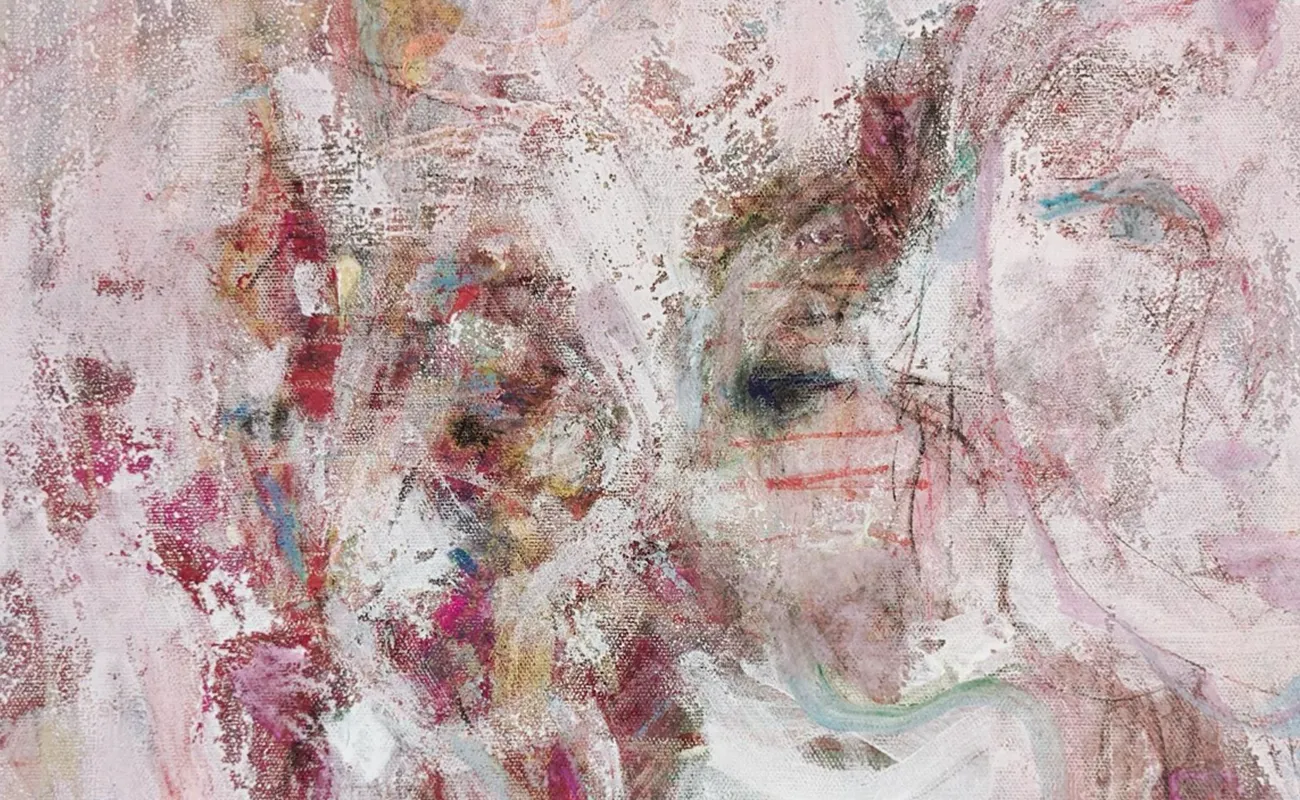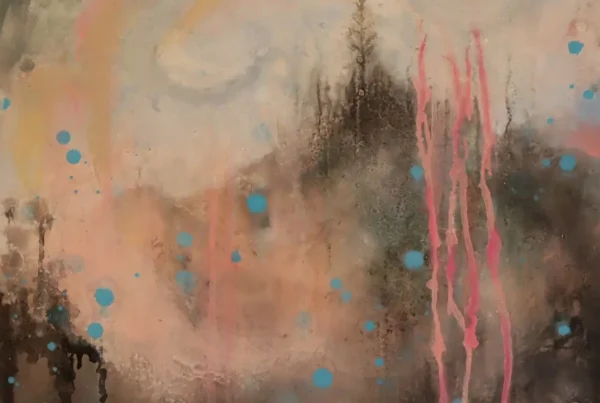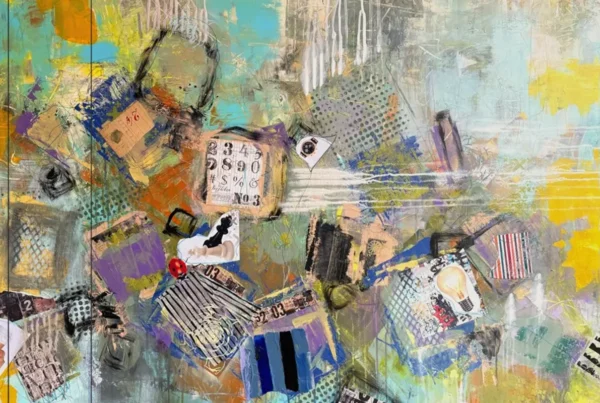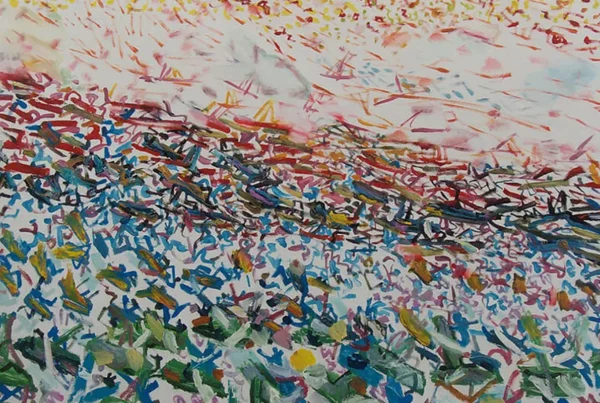“By using materials with opposing properties, I aim to create a completely new world through harmony and mutual acknowledgment.”
The Roots of Inspiration: Nature and Cultural Legacy
Tahara Mio‘s art reflects a profound bond with nature, drawing inspiration from her childhood experiences around Mishima Taisha Shrine, where nature worship was part of everyday life. Her early exposure to birds, insects, and fish left a lasting impression, making them recurring subjects in her paintings. Tahara was raised in Tokyo but often spent school breaks in her family’s hometown at the foot of Mount Fuji. Here, she absorbed the cultural essence of rural Japan: the area was abundant in pure spring water, supporting koi and rainbow trout in home ponds, and the rhythms of rural life involved activities like charcoal burning on hillside slopes and bamboo shoot harvesting in the spring. This immersion in nature and the local lifestyle became integral to her art.
Tahara’s work also draws from the philosophies embedded in her family’s samurai lineage, a background where adult decisions ruled, leaving her as a child yearning to be heard. Her art often embodies this need to voice the perspectives of the young—a reaction against the “feudal” constraints of her upbringing. This sentiment intensified during her student years when she encountered teachings from the Mahāparinirvāṇa Sūtra, igniting a desire to portray themes of liberation and self-expression in her paintings. She describes her work as a way to reflect her inner journey toward freedom from the limitations placed upon her by tradition.
Influences from renowned artists have also deeply shaped Tahara’s approach to art. Discovering the works of Cézanne, she became fascinated with the evolution from firmly capturing form to abstracting it—a journey she mirrored in her own graduation project. “Beginning with Cézanne, ending with Cézanne” is a motto at her alma mater, reflecting a distinct approach that resonates with her artistic philosophy. Additionally, encountering the surreal artwork of Professor Akiko Endo, a mentor from the previous generation at Musashino Art University, moved her deeply and further inspired her creative expression.
Her journey continued under the tutelage of her elementary art teacher, who recognized her talent early on and urged her mother to foster her abilities. Her junior high art teacher, too, was astonished by the maturity of her work, so much so that it sparked a conversation about her family challenges. These formative years shaped her emotional connection to her work, where frustration over her lack of control in her educational path translated onto the canvas, allowing her to communicate her struggles through art.
Her path to professional artistry eventually led Tahara to Musashino Art University, an institution known for producing distinguished artists. Immersed in an environment that fostered artistic expression, she was surrounded by mentors and peers who nurtured her talent. The university’s emphasis on both tradition and innovation allowed her to blend her appreciation for historical masters with her own contemporary vision. Under the guidance of esteemed professors like Akiko Endo, Tahara’s practice was enriched, blending a sense of heritage with formal artistic training.
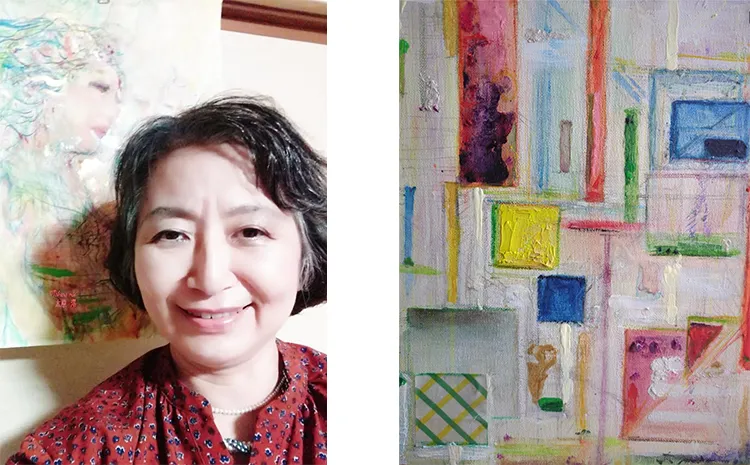
Tahara Mio: An Artistic Legacy Forged in Inspiration and Discipline
Mio’s journey into the art world was deeply influenced by her family’s creative lineage. Her father, an architect, devoted his later years to the delicate craft of Noh mask carving, a traditional Japanese art form steeped in history and storytelling. The transformative power of these masks, which bridge the ancient and contemporary through ritualistic performance, captivated Mio and ignited her passion for exploring humanity’s timeless narratives. Her grandmother, another central figure in Mio’s artistic awakening, exemplified resilience and creativity. A self-taught painter, she defied societal norms by embracing art in her later years, garnering recognition in prestigious exhibitions such as the Ueno Women Painters’ Exhibition.
Mio’s formal artistic education at Musashino Art University solidified her foundation and honed her natural talents. This institution, renowned for its philosophy of grounding artistic exploration in the works of Cézanne, provided her with both technical skills and conceptual depth. Her transition from faithfully rendering objects to abstracting them marked a significant evolution in her artistic identity. This transformation, first realized in her graduation project, continues to shape her creative ethos, bridging precision with imaginative abstraction.
Her early artistic milestones also reflect a natural talent nurtured by an encouraging environment. Teachers, both in school and at university, recognized Mio’s unique vision, guiding her to refine her skills. Whether painting alongside her family during holidays or creating bold, emotive works that prompted reflection and dialogue, Mio’s path has been one of continuous growth, shaped by an instinctive drive for excellence.

Layers of Meaning: Symbols, Themes, and Process in Mio’s Art
The motifs and techniques that define Mio’s art are a testament to her thoughtful engagement with both material and meaning. At the heart of her creations is a fascination with humanity’s relationship with nature, explored through recurring symbols like fire, water, and animals. Her works often depict transitions, such as the evolution from dinosaurs to birds, highlighting the interconnectedness of life and the forces that shape existence. This thematic focus extends to cultural artifacts like pyramids and clay dogū, which Mio interprets as emblems of a universal yearning for simplicity and harmony.
Her painting process is equally distinctive, characterized by an embrace of experimentation and transformation. Drawing from the philosophy of artists like Picasso, who saw unfinished works as opportunities for reinvention, Mio often reworks her canvases until they align with her exacting vision. This iterative process might involve scraping away layers of oil paint or integrating unconventional materials such as fabrics and paper to achieve dynamic textures and balance. Her unique use of gofun, a traditional white pigment, adds an element of Japanese craftsmanship to her pieces, connecting her contemporary style to historical techniques.
Among her notable works is one depicting The Severance of Pride (below), a richly symbolic piece that merges abstraction with figuration. Central to the composition is an elongated nose, a nod to the tengu of Japanese folklore, which embodies themes of arrogance and transformation. The juxtaposition of a child with scissors introduces a provocative tension, critiquing human hubris while exploring the potential for renewal. Through vivid color washes and layered textures, Mio creates an atmosphere that is both ethereal and emotionally charged, inviting viewers to engage deeply with its philosophical undertones.

Tahara Mio: The Colors of Creative Evolution
Mio’s exploration of mediums and techniques reflects her relentless pursuit of artistic innovation. Beginning with oil paints for their luminous qualities, she transitioned to acrylic resin to better suit her evolving needs. This shift allowed her to experiment with layering and texture, leading to the development of her signature style. Whether incorporating watercolors for their transparency or solidifying oil paints with gofun, Mio’s ability to adapt her methods to her vision is a hallmark of her artistry.
Her workspace is a repository of ideas, filled with sketches and visual notes that capture fleeting moments of inspiration. This practice stems from her days at Musashino Art University, where she adhered to the tradition of creating expansive sketchbooks as a foundation for artistic exploration. These studies often evolve into fully realized works, imbued with the spontaneity and vitality of their origins.
Looking to the future, Mio envisions projects that expand the boundaries of her creativity. Among her aspirations is a picture book that echoes the universal charm of Eric Carle’s The Very Hungry Caterpillar, blending narrative with visual art to inspire wonder across generations. This endeavor reflects her enduring commitment to crafting art that connects deeply with audiences, offering both aesthetic beauty and thoughtful reflection. Through her ongoing journey, Mio remains a powerful voice in contemporary art, bridging tradition and innovation with unparalleled sensitivity.
For those curious to explore more of her work, I invite you to visit my profiles on Artmajeur and Tricera, which serve as platforms for showcasing my art to a broader audience.
